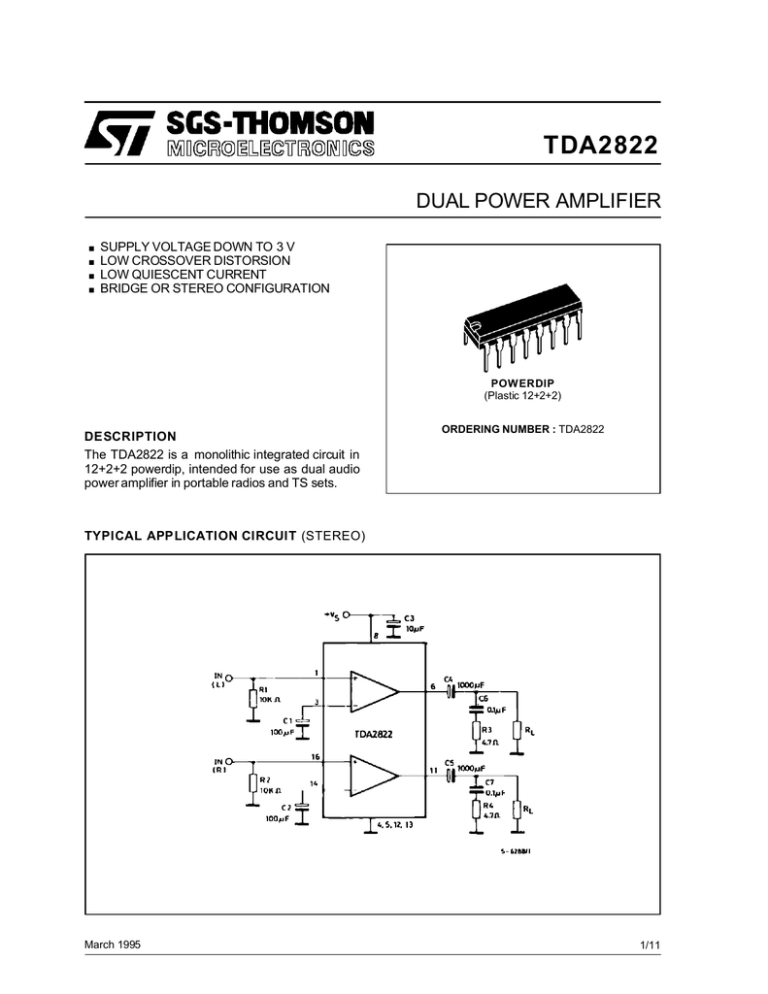
TDA2822
DUAL POWER AMPLIFIER
..
..
SUPPLY VOLTAGE DOWN TO 3 V
LOW CROSSOVER DISTORSION
LOW QUIESCENT CURRENT
BRIDGE OR STEREO CONFIGURATION
POW ERDIP
(Plastic 12+2+2)
DESCRIPTION
The TDA2822 is a monolithic integrated circuit in
12+2+2 powerdip, intended for use as dual audio
power amplifier in portable radios and TS sets.
ORDERING NUMBER : TDA2822
TYPICAL APPLICATION CIRCUIT (STEREO)
March 1995
1/11
TDA2822
PIN CONNECTION (top view)
SCHEMATIC DIAGRAM
ABSOLUTE MAXIMUM RATINGS
Symbol
Value
Unit
Vs
Supply Voltage
15
V
Io
Output Peak Current
1.5
A
Total Power Dissipation at Tamb = 50 °C
at Tcase = 70 °C
1.25
4
W
W
– 40 to 150
°C
Ptot
Tstg, Tj
2/11
Parameter
Storage and Junction Temperature
TDA2822
THERMAL DATA
Symbol
Rth j-amb
R th j-case
Parameter
Thermal Resistance Junction-ambient
Thermal Resistance Junction-pins
Max
Max
Value
Unit
80
20
°C/W
°C/W
ELECTRICAL CHARACTERISTICS (Vs = 6 V, Tamb = 25 °C, unless otherwise specified)
STEREO (test circuit of fig. 1)
Symbol
Parameter
Vs
Supply Voltage
Vc
Quiescent Output Voltage
Test Condition
Quiescent Drain Current
Input Bias Current
Po
Output Power
(each channel)
d = 10 %
Vs = 9 V
Vs = 6 V
Vs = 4.5 V
Gv
Closed Loop Voltage Gain
Ri
Input Resistance
e
Total Input Noise
Rs = 10 kΩ
B = 22 Hz to 22 kHz
Curve A
CS
Max.
15
4
2.7
Vs = 9 V
Vs = 6 V
Id
SVR
Typ.
3
Ib
N
Min.
6
Unit
V
V
V
12
mA
100
nA
1.3
0.45
1.7
0.65
0.32
W
W
W
f = 1 kHz
36
39
f = 1 kHz
100
f = 1 kHz
RL = 4 Ω
RL = 4 Ω
RL = 4 Ω
Supply Voltage Rejection
f = 100 Hz
Channel Separation
Rg = 10 kΩ f = 1 kHz
24
41
dB
kΩ
2.5
2
µV
µV
30
dB
50
dB
BRIDGE (test circuit of fig. 2)
Vs
Supply Voltage
Id
Quiescent Drain Current
RL = ∞
Output Offset Voltage
RL = 8 Ω
Vos
Ib
Input Bias Current
Po
Output Power
3
d = 10 % f = 1 kHz
Vs = 9 V RL = 8 Ω
Vs = 6 V R L = 8 Ω
Vs = 4.5 V RL = 4 Ω
2.7
0.9
15
V
6
12
mA
10
60
mV
100
nA
3.2
1.35
1
W
W
W
d
Distortion (f = 1 kHz)
RL = 8 Ω
Gv
Closed Loop Voltage Gain
f = 1 kHz
Ri
Input Resistance
f = 1 kHz
e
Total Input Noise
Rs = 10 kΩ
B = 22 Hz to 22 kHz
Curve A
3
2.5
µV
µV
f = 100 Hz
40
dB
N
SVR
Supply Voltage Rejection
Po = 0.5 W
0.2
%
39
dB
100
kΩ
3/11
TDA2822
Figure 1 : Test Circuit (stereo).
Figure 2 : P.C. Board and Components Layout of the Circuit of Figure 1 (1:1 scale).
4/11
TDA2822
Figure 3 : Test Circuit (bridge).
Figure 4 : P.C. Board and Components Layout of the Circuit of Figure 3 (1:1 scale).
5/11
TDA2822
Figure 5 : Output Power vs. Supply Voltage
(Stereo).
Figure 6 : Output Power vs. Supply Voltage
(Bridge).
Figure 7 : Distorsion vs. Output Power (Bridge).
Figure 8 : Distorsion vs. Output Power (Bridge).
Figure 9 : Supply Voltage Rejection vs.
Frequency.
Figure 10 : Quiescent Current vs. Supply Voltage.
6/11
TDA2822
Figure 11 : Total Power Dissipation vs. Output
Power (Stereo).
Figure 12 : Total Power Dissipation vs. Output
Power (Bridge).
Figure 13 : Total Power Dissipation vs. Output
Power (Bridge).
7/11
TDA2822
Figure 14 : Application Circuit for Portable Radios.
MOUNTING INSTRUCTION
The Rth j-amb of the TDA2822 can be reduced by soldering the GND pins to a suitable copper area of the
printed circuit board (Figure 15) or to an external
heatsink (Figure 16).
The diagram of Figure 17 shows the maximum dissipable power Ptot and the Rth j-amb as a function of
the side ”∂” oftwo equalsquare copperareas having
a thickness of 35 µ (1.4 mils).
Figure 15 : Example of P.C. Board Copper Area
which is used as Heatsink.
8/11
During soldering the pins temperature must not exceed 260 °C and the soldering time must not be
longer than 12 seconds.
The external heatsink or printed circuit copper area
must be connected to electrical ground.
Figure 16 : External Heatsink Mounting Example.
TDA2822
Figure 6 : Maximum Dissipable Power and
Junction to Ambient Thermal
Resistance vs. Side ”∂”.
Figure 7 : Maximum Allowable Power Dissipation
vs. Ambient Temperature.
9/11
TDA2822
POWERDIP 16 PACKAGE MECHANICAL DATA
mm
DIM.
MIN.
a1
0.51
B
0.85
b
b1
TYP.
MAX.
MIN.
TYP.
MAX.
0.020
1.40
0.033
0.50
0.38
0.055
0.020
0.50
D
0.015
0.020
20.0
0.787
E
8.80
0.346
e
2.54
0.100
e3
17.78
0.700
F
7.10
0.280
I
5.10
0.201
L
Z
10/11
inch
3.30
0.130
1.27
0.050
TDA2822
Information furnished is believed to be accurate and reliable. However, SGS-THOMSON Microelectronics assumes no responsibility for
the consequences of use of such information nor for any infringement of patents or other rights of third parties which may result from its
use. No license is granted by implication or otherwise under any patent or patent rights of SGS-THOMSON Microelectronics. Specifications mentioned in this publication are subject to change without notice. This publication supersedes and replaces all information previously supplied. SGS-THOMSON Microelectronics products are not authorized for use as critical components in life support devices or
systems without express written approval of SGS-THOMSON Microelectronics.
1995 SGS-THOMSON Microelectronics - All Rights Reserved
SGS-THOMSON Microelectronics GROUP OF COMPANIES
Australia - Brazil - France - Germany - Hong Kong - Italy - Japan - Korea - Malaysia - Malta - Morocco - The Netherlands - Singapore Spain - Sweden - Switzerland - Taiwan - Thaliand - United Kingdom - U.S.A.
11/11




